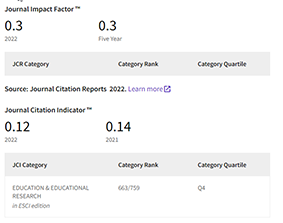



Space and Time are two variables which, to a large extent, determine reality, make a mark on all its aspects, condition the opportunities and paths of people and societies, as well as those of thought, science, technology and many other manifestations of Reason, Freedom and Utopia. Education, a genuinely human phenomenon, is no stranger to such influences: it is a past and a present factor which is both conditioning and conditioned over the course of history and the present.
Espacio, Tiempo y Educación is an open access, independent scientific journal, with a six-monthly periodicity (two issues every year) published by FahrenHouse (Salamanca, Spain). The main object of the journal consists in publishing researches, studies and critical essays about the History of Education, in any space and time, adopting theoretical, philosophical and methodological perspectives. Generally the structure of each number is composed by editorial, monographic, studies and interview. All items received by Espacio, Tiempo y Educación for the sections “Monographic” and “Studies” are submitted to the double blind peer review external evaluation process. Espacio, Tiempo y Educación accepts articles in different languages as Spanish, English, Italian and Portuguese (more information in “Guidelines for the Authors”).
Espacio, Tiempo y Educación addresses mainly researchers, scholars and academics in the field of the History of Education, as well as other independent people who care about issues of thought, culture, society and education in a historical perspective and who are willing to debate their policies and researches with others.
The deadline for submitting articles for the Studies section remains open during the whole year.
Espacio, Tiempo y Educación (FahrenHouse: Salamanca, Spain). ISSN: 2340-7263. DOI prefix: http://dx.doi.org/10.14516/ete
Indexed in
CNKI-Scholar (China National Knowledge Infrastructure - China Academic Journals Full-text Database) // Dialnet // DOAJ (Directory of Open Access Journals) // EBSCO Education Source // EBSCO Host // ERIH PLUS – European Reference Index for the Humanities and Social Sciences // ESCI (Emerging Sources Citation Index – Clarivate Analytics) // Google Scholar // IRESIE // ISOC – Base de datos // Latindex // MIAR (Matriz de Información para el Análisis de Revistas) ICDS: 8.8 // OAJI (Open Academic Journals Index) // REDIB – Red Iberoamericana de Innovación y Conocimiento Científico // Scopus® (Elsevier B.V.) // Web of Science – Clarivate Analytics
Editorial Quality Evidence
Agenzia Nazionale di Valutazione del Sistema Universitario e della Ricerca (ANVUR – Italia): Nivel A // ERIH PLUS – European Reference Index for the Humanities and Social Sciences // ESCI (Emerging Sources Citation Index – Clarivate Analytics) // FECYT (Fundación Española para la Ciencia y la Tecnología) // MIAR (Matriz de Información para el Análisis de Revistas) ICDS: 8.8 // Qualis CAPES (Coordenação de Aperfeiçoamento de Pessoal de Nível Superior – Brasil): B3 // Scopus® (Elsevier B.V.) // SJR - Scimago: 0.17 (History Q2; Philosophy Q2; Sociology and Political Science Q3; Education Q4).
ISSN: 2340-7263
DOI prefix: 10.14516/ete
URL: www.espaciotiempoyeducacion.com
FahrenHouse: Salamanca, Spain

Attribution-NonCommercial-NoDerivatives 4.0 International (CC BY-NC-ND 4.0)
